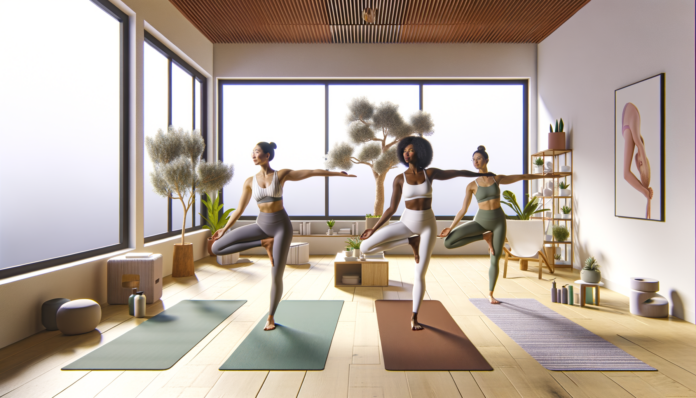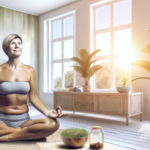Introduction to Holistic Fitness
Understanding the Mind-Body Connection
The concept of holistic fitness transcends traditional exercise, focusing on the integration of mind, body, and spirit. At its core, the mind-body connection is the understanding that our thoughts, feelings, and beliefs can positively or negatively affect our biological functioning. In holistic fitness, this connection is nurtured through practices that promote mental clarity, emotional balance, and physical health. Yoga and Pilates, for instance, are not just workouts for the body but also for the mind, encouraging mindfulness and concentration during each movement.
The Role of Yoga and Pilates in Modern Fitness
Yoga and Pilates have become pillars in the modern fitness landscape, offering a counterbalance to high-intensity workouts. These practices emphasize core strength, flexibility, and alignment, which are essential for overall fitness and well-being. They also encourage a deeper awareness of breath and movement, leading to improved posture and mental focus. In a world where fitness is often equated with physical exertion, Yoga and Pilates stand out by promoting a more measured and introspective approach to exercise.
Benefits of Combining Yoga and Pilates
When Yoga and Pilates are combined, they create a comprehensive fitness routine that enhances both strength and flexibility. This synergy offers numerous benefits, including:
- Enhanced Core Strength: Pilates’ targeted exercises complement the stability work in Yoga, leading to a more robust and controlled core.
- Improved Body Awareness: The precision of Pilates and the fluidity of Yoga together foster a deeper understanding of one’s body and alignment.
- Increased Muscle Tone and Definition: Pilates adds resistance training to the flexibility of Yoga, resulting in a balanced physique.
- Better Posture and Alignment: Both practices focus on proper alignment, reducing the risk of injury and strain.
- Injury Prevention and Rehabilitation: Pilates is particularly beneficial for injury prevention and recovery, complementing the gentle stretching and strengthening of Yoga.
Setting Realistic Fitness Goals
Embarking on a fitness journey with Yoga and Pilates requires setting realistic and achievable goals. It’s important to consider one’s current fitness level, lifestyle, and personal aspirations. Goals should be specific, measurable, attainable, relevant, and time-bound (SMART). Whether it’s improving flexibility, building core strength, or enhancing mental well-being, setting clear objectives can help maintain motivation and measure progress. Remember, the journey to fitness is a marathon, not a sprint, and every small achievement is a step towards a stronger and more balanced you.
Yoga: A Path to Inner Strength and Flexibility
Key Principles of Yoga
Yoga is an ancient practice that harmonizes the body, mind, and spirit. Central to yoga are the principles of mindfulness, breath control, and the balance between strength and flexibility. Mindfulness encourages a heightened state of awareness and focus, while breath control, or pranayama, is essential for managing the body’s energy flow. The physical postures, or asanas, are designed to strengthen the body, improve flexibility, and promote a sense of inner peace.
Yoga Poses for Core Strength and Stability
Core strength is vital for overall stability and balance in yoga. Poses such as Plank (Phalakasana), Boat (Navasana), and Warrior III (Virabhadrasana III) are excellent for building a strong and stable core. These asanas engage the deep abdominal muscles, back, and pelvic floor, contributing to better posture and reducing the risk of injury in daily activities.
Breathing Techniques for Enhanced Vitality
Pranayama, or the art of breath control, plays a crucial role in yoga. Techniques such as Ujjayi (Victorious Breath), Kapalabhati (Skull Shining Breath), and Nadi Shodhana (Alternate Nostril Breathing) help regulate the flow of energy, calm the mind, and improve respiratory efficiency. Regular practice of pranayama can lead to increased vitality and a profound sense of well-being.
Yoga Sequences for Daily Practice
Integrating yoga into daily life can be achieved through simple sequences that cater to all levels of experience. A typical sequence might begin with gentle warm-up stretches, progress to a series of standing poses like Triangle (Trikonasana) and Tree (Vrksasana) for balance, and conclude with seated forward bends and a final relaxation pose, Savasana. Consistent practice is key to reaping the full benefits of yoga, including improved strength, flexibility, and mental clarity.
By embracing these principles and incorporating a variety of poses and breathing techniques into a regular routine, individuals can build a foundation for a stronger, more flexible, and balanced self.
Pilates: Precision and Control for a Toned Body
Core Concepts of Pilates
Pilates, often referred to as the Pilates method, is a form of exercise that emphasizes the balanced development of the body through core strength, flexibility, and awareness. Developed by Joseph Pilates in the early 20th century, this practice focuses on the deep core muscles, promoting improved posture, muscle tone, and mental well-being. Pilates exercises require precision and control, with movements performed through a range of motion that is both deliberate and thoughtful. Unlike some forms of exercise that push muscles to exhaustion, Pilates values the quality of each posture over the quantity of repetitions, fostering an environment of intense concentration and mindful execution.
Pilates Exercises for Muscle Toning
Pilates is renowned for its ability to tone muscles without adding bulk, creating a sleek and toned physique. The exercises are designed to target the powerhouse, or core, which includes the abdominal muscles, lower back, hips, and buttocks. By engaging these muscles, Pilates supports the body’s structure and enhances overall health. Some key exercises include:
- The Hundred: A breathing exercise that stimulates the core and respiratory muscles.
- Leg Circles: Enhances hip flexibility and abdominal stability.
- Plank: Strengthens the abdominals, shoulder girdle stabilizers, and legs.
These exercises, when performed with the Pilates principles of alignment and precision, contribute to a toned and balanced body.
The Importance of Alignment and Posture
Proper alignment and posture are central to the Pilates method. Each exercise is crafted to align the spine and strengthen the muscles that maintain this alignment. This focus on posture not only improves appearance but also ensures that the body functions efficiently, reducing the risk of injury and chronic pain. Pilates teaches awareness of breath and alignment of the spine, aiding in the correction of postural imbalances and providing a foundation for strength and grace in movement.
Building a Pilates Routine at Home
Creating a Pilates routine at home can be both convenient and effective. To start, it is essential to learn the basic principles and exercises from a qualified instructor. Once the fundamentals are understood, a home practice can consist of a series of mat exercises that require no special equipment. A typical home routine might include:
- A warm-up focusing on breath and gentle stretching
- A series of core exercises such as the Hundred, Roll-Up, and Teaser
- Lower body exercises like Side Kicks and Leg Pulls
- Upper body exercises including the Push-Up and Chest Expansion
- A cool-down with stretches to enhance flexibility and relaxation
Consistency is key, and even short, daily sessions can lead to significant improvements in strength and posture.
By integrating the core concepts of Pilates into daily routines, individuals can achieve a stronger, more balanced body. The combination of muscle toning exercises, a focus on alignment and posture, and the ability to practice at home makes Pilates an accessible and effective form of exercise for individuals seeking holistic fitness.
Creating a Balanced Routine
Integrating Yoga and Pilates into Your Lifestyle
Adopting a holistic approach to fitness involves more than just sporadic workouts; it requires integrating practices like Yoga and Pilates into your daily life. To seamlessly blend these disciplines into your routine, consider them as essential as your morning coffee or evening wind-down. Start small, with a few minutes each day, and gradually increase the duration as your body adapts and your interest grows. Remember, consistency is key to reaping the full benefits of these mind-body exercises.
Designing a Weekly Schedule for Variety and Consistency
Creating a weekly schedule that includes both Yoga and Pilates ensures you maintain variety in your workouts while establishing consistency. A balanced week might look like this:
- Monday: Morning Yoga to kickstart the week with energy and focus.
- Wednesday: Midweek Pilates to strengthen the core and improve posture.
- Friday: Yoga flow to unwind and reflect on the week’s accomplishments.
- Sunday: A restorative Pilates session to prepare for the week ahead.
Adjust the intensity and length of each session to fit your personal schedule and energy levels.
Adapting Workouts to Your Fitness Level and Needs
It’s crucial to tailor your workouts to your current fitness level and personal health goals. Beginners should focus on mastering the basics of each practice, prioritizing form and alignment over intensity. As you progress, you can introduce more challenging poses and Pilates exercises. Listen to your body and modify movements to accommodate any physical limitations or to increase the challenge as needed.
Tips for Staying Motivated and Accountable
Maintaining motivation can be challenging, but there are strategies to help you stay on track:
- Set Clear Goals: Define what you want to achieve with your Yoga and Pilates practice, whether it’s increased flexibility, stronger core muscles, or better stress management.
- Track Your Progress: Keep a journal or use an app to log your workouts and celebrate your improvements over time.
- Find a Workout Buddy: Partner with a friend who shares your fitness interests to encourage each other and add a social element to your routine.
- Join a Community: Participate in online forums or local classes to connect with others who can offer support and advice.
- Mix It Up: Prevent boredom by varying your routines, trying new Yoga flows or Pilates exercises, and occasionally attending different classes.
Remember, the journey to a stronger you is a marathon, not a sprint. Embrace the process, and the results will follow.
Nutrition and Recovery
Eating for Strength and Recovery
Proper nutrition is a cornerstone of any effective fitness routine, particularly when it comes to strength and recovery. A balanced diet rich in proteins, carbohydrates, and healthy fats supports muscle repair and growth. After a workout, consuming protein can help repair muscle fibers, while carbohydrates replenish glycogen stores depleted during exercise. It’s essential to focus on whole foods, such as lean meats, whole grains, and a variety of fruits and vegetables, to provide the body with the nutrients it needs to recover and become stronger.
Hydration and Its Role in Fitness
Hydration is crucial for maintaining optimal performance during workouts and for the recovery process. Water regulates body temperature, lubricates joints, and helps transport nutrients to give you energy. When you’re well-hydrated, you can exercise more effectively and for longer periods. During recovery, staying hydrated helps the body flush out toxins and reduces muscle soreness. Aim to drink water consistently throughout the day, and consider electrolyte-replenishing beverages after intense workouts to restore fluid balance.
Restorative Practices for Post-Workout Recovery
Restorative practices such as yoga, Pilates, and stretching play a significant role in post-workout recovery. These activities promote flexibility, reduce muscle tension, and can help prevent injury. Incorporating restorative practices into your routine can also improve circulation, which is vital for delivering nutrients to muscles and aiding in the repair process. Additionally, techniques like foam rolling can help release muscle knots and improve range of motion.
Supplements and Natural Health Products
While a well-rounded diet is the best way to get the nutrients you need, supplements and natural health products can provide additional support. For example, protein powders can be a convenient post-workout option, omega-3 supplements may reduce inflammation, and vitamin D can support bone health. However, it’s important to approach supplements with caution and consult with a healthcare professional before starting any new supplement regimen, as they should complement, not replace, a nutritious diet.
Overcoming Common Challenges
Dealing with Plateaus and Setbacks
It’s natural in any fitness journey to encounter plateaus where progress seems to stall, or setbacks such as minor injuries or motivation dips. To overcome these hurdles, it’s crucial to reassess and adjust your routine. Introduce new yoga poses or Pilates exercises to challenge your body in different ways. Remember, progress is not always linear, and sometimes, taking a step back can propel you two steps forward. Celebrate small victories and be patient with your body’s pace of change.
Injury Prevention and Management
Both yoga and Pilates emphasize mindful movement and body awareness, which are key to preventing injuries. Focus on proper form and alignment rather than pushing into painful ranges of motion. If an injury does occur, consult a healthcare professional and consider gentle rehabilitative exercises. Incorporate restorative yoga sessions and modified Pilates routines that support healing while maintaining fitness.
Balancing Fitness with a Busy Schedule
Finding time for fitness can be challenging with a busy schedule. To stay consistent, plan your workouts as you would any important appointment. Opt for shorter, more intense sessions when time is limited and take advantage of weekend mornings for longer practices. Remember, even a 10-minute yoga flow or Pilates sequence can be beneficial when practiced regularly.
Maintaining Fitness During Travel or Holidays
Travel and holidays can disrupt your fitness routine, but they don’t have to halt your progress. Pack a travel yoga mat and explore online classes or apps that offer guided sessions. Take advantage of hotel gyms for Pilates mat exercises or use resistance bands for strength training. Embrace activities like walking or cycling to explore new places while staying active. Most importantly, be adaptable and enjoy the variety that comes with change.
By addressing these common challenges with flexibility, patience, and creativity, you can maintain a balanced fitness routine that contributes to a stronger, more resilient you.
Conclusion: Embracing a Lifetime of Wellness
Celebrating Progress and Setting New Goals
As we journey through the realms of yoga and Pilates, it’s essential to pause and acknowledge the milestones we’ve achieved. Celebrating progress, no matter how small, fuels our motivation and propels us forward. It’s a testament to our dedication and hard work. But the path to wellness doesn’t end here; it’s a continuous cycle of self-improvement. Setting new goals keeps us challenged and ensures that our routines never become stagnant. Whether it’s mastering a complex yoga pose or enhancing Pilates precision, each new objective is a step towards a stronger, more balanced you.
The Continuous Journey of Self-Improvement
Wellness is not a destination but a way of living. Embracing this philosophy means recognizing that our bodies and minds are always evolving. As such, our routines should adapt to reflect our changing needs and aspirations. The combination of yoga and Pilates offers a versatile framework for growth, allowing us to fine-tune our practices to whatever life throws our way. This journey of self-improvement is lifelong, and with each breath and movement, we learn more about ourselves and our potential.
Building a Supportive Community for Fitness
One of the most powerful aspects of a wellness journey is the community we build along the way. Sharing experiences, challenges, and successes with others creates a supportive environment that can uplift us during tough times. Engage with local yoga and Pilates groups, online forums, or even start your own fitness circle. A community fosters accountability, provides a wealth of knowledge, and can be a source of inspiration and encouragement.
Final Thoughts on Achieving Balance
Achieving balance in our fitness routines is akin to finding harmony in life. It’s about blending strength with flexibility, control with freedom, and effort with ease. As we integrate the principles of yoga and Pilates into our daily lives, we not only sculpt our bodies but also cultivate a mindset that embraces peace and resilience. Remember, balance is not static; it’s a dynamic state that we must continuously strive for. With each inhale and exhale, with every stretch and contraction, we are on the path to a stronger, more balanced self.








